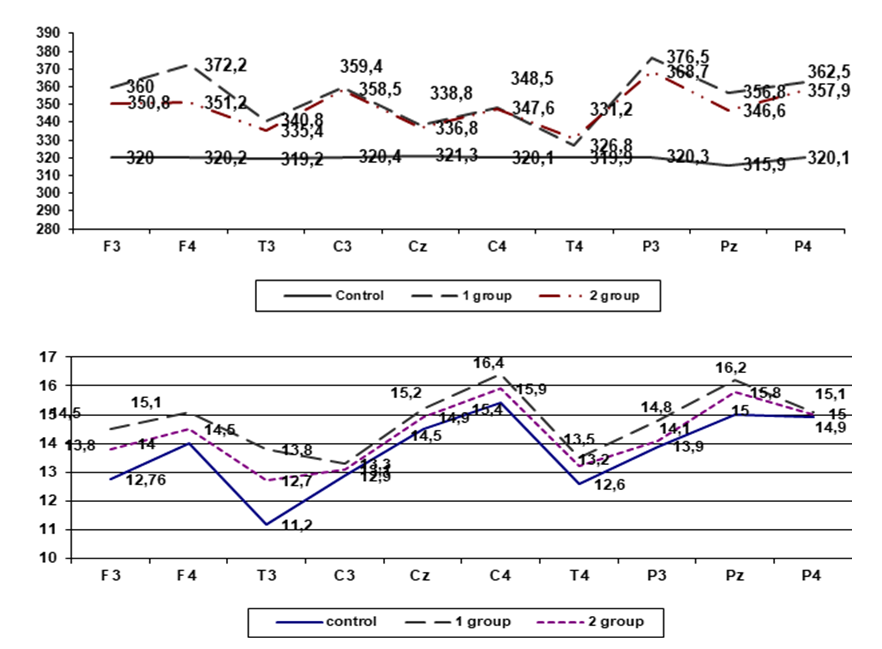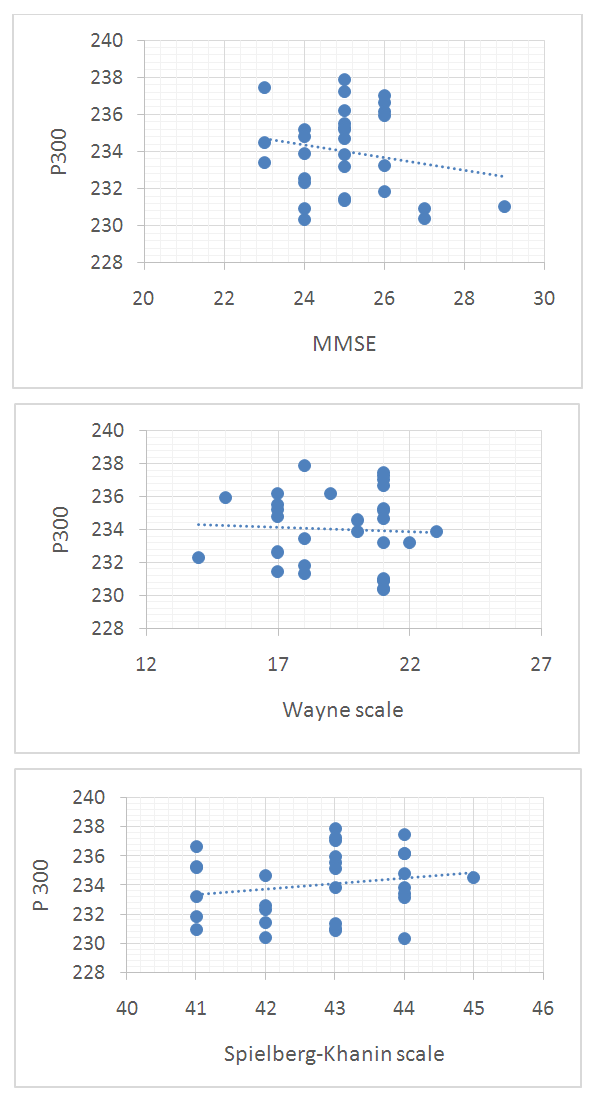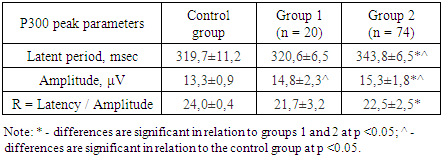-
Paper Information
- Next Paper
- Previous Paper
- Paper Submission
-
Journal Information
- About This Journal
- Editorial Board
- Current Issue
- Archive
- Author Guidelines
- Contact Us
American Journal of Medicine and Medical Sciences
p-ISSN: 2165-901X e-ISSN: 2165-9036
2021; 11(3): 224-227
doi:10.5923/j.ajmms.20211103.13
Received: Feb. 27, 2021; Accepted: Mar. 20, 2021; Published: Mar. 28, 2021

Estimation of the Cognitive Evoked Potentials of the Brain (P-300) in Young Persons with Arterial Hypotension
Djurabekova Aziza Taxirovna1, Mamurova Mavlyuda Mirxamzaevna2
1Doctor of Medical Sciences, Prof. Head of the Department of Neurology and Neurosurgery, Samarkand State Medical Institute, Uzbekistan
2PhD Student, Assistant of the Department of Neurology and Neurosurgery Samarkand State Medical Institute, Uzbekistan
Copyright © 2021 The Author(s). Published by Scientific & Academic Publishing.
This work is licensed under the Creative Commons Attribution International License (CC BY).
http://creativecommons.org/licenses/by/4.0/

According to statistics, in Uzbekistan, mortality from stroke remains high. In the last decade, studies in the field of cerebral vascular pathology with the study of atherosclerosis in arterial hypertension, the issue of arterial hypotension as a factor preceding cerebrovascular accident remains practically unexplored (1, 3). The terminology of arterial hypotension and its nosological affiliation are diverse, so in some sources this symptom is considered the norm, in others, they come to the conclusion about a long-term illness, or can become a risk factor for arterial hypertension and other diseases of the cardiovascular system (4, 8). In the pathogenesis of arterial hypotension, several concepts have been put forward, in which priority is given to the violation of various links of regulation, vascular tone, these include asthenic-vegetative, constitutional-hereditary, endocrine theory (2, 5). In relatively recent scientific publications, one can find data on neuropsychological disorders in patients with arterial hypotension, dynamics in the age aspect, anxiety and differences in excitability. The most interesting in literature reviews is the nature of the study of thinking, fixation on secondary issues or a painful sensation, worry over trifles, viscosity of thinking. Almost the root causes of the change were found in studies: a decrease in memory for current events and a decrease in productivity for the assimilation of educational material, a decrease in attention activity (6, 7, 9). In this regard, an important and urgent problem of modern neurology is the study of clinical and paraclinical features of arterial hypotension (AGI).
Keywords: Asthenic-vegetative, Cerebrovascular, Paraclinical, Nosological
Cite this paper: Djurabekova Aziza Taxirovna, Mamurova Mavlyuda Mirxamzaevna, Estimation of the Cognitive Evoked Potentials of the Brain (P-300) in Young Persons with Arterial Hypotension, American Journal of Medicine and Medical Sciences, Vol. 11 No. 3, 2021, pp. 224-227. doi: 10.5923/j.ajmms.20211103.13.
1. Introduction
- To establish the frequency of occurrence (AGI) of arterial hypertension, 216 employees of the 1-Clinic SamMI at the age from 20 to 40 were questioned. In addition, 27 patients were examined who received inpatient treatment in the neurology department of the 1-Clinic SamMI of the same age. Based on the questionnaire, 67 people were selected according to the boil questionnaire, which scored 24 points, which indicated the presence of low blood pressure, in all cases SBP (systolic blood pressure) was below 100 mm Hg. and DAPT (diastolic blood pressure) below 65 mm Hg. from the anamnesis it was established that the duration of low blood pressure varied on average 14.8 ± 0.3 years, of which 67.2% indicated these figures from adolescence. Overweight was characteristic, it was 25.3 ± 2.4 kg / m2 (p <0.05). The exclusion criteria were patients with stenosis, heart disease, cardiomyopathy, diabetes mellitus, anemia, and hypoplasia of the thyroid gland. As a result of the survey, a comparative analysis of the detection of cognitive deficit was carried out and the risk factors for its development were established, in connection with which all surveys (94) were subdivided into 2 groups; 1 group of 20 people with self-form disorders (SFD), group 2 74 people with signs of chronic cerebral ischemia. All examined patients underwent a standard neurological examination, somatic status checks by therapists, and neuropsychological testing. Diagnostic studies include ECG, USDG, MRI studies, cognitive evoked potential P-300. Statistical processing was carried out on an individual computer, correlation analysis was performed using the methods of Spearman and Pearson.
2. Research Result
- The most common complaint in hypertensive patients was headaches and dizziness, which prevailed in group 2. The control group also had headaches, but almost 3 times less and their occurrence was associated with a stressful situation. However, the connection between the occurrence of headaches and a decrease in blood pressure was more often indicated by patients of group 1. Also, in a larger number of patients of group 1, a decrease in working capacity was noted. Cephalalgias were pulsating in 39.3% of patients, compressive in 18% of patients, bursting in 16.4% of patients, pressing in 26.2% of patients and diffuse in 19.7% of patients. However, the differences in the nature of headaches in hypertensive patients in the indicated groups were statistically insignificant. Headaches occurred in 17 (85%) patients in group 1 and 72 (97.3%) in group 2; in the control group, headaches occurred in 58 (39.7%), which is almost 2 times less frequent (P <0, 05). In group 1 and in the control group, cephalalgias did not depend on the time of day, while in group 2 they predominantly appeared in the morning or in the afternoon. Symptoms of morning asthenia (difficulty waking up, impossibility of active mental and physical activity immediately after sleep) in group 1 disturbed 60.0% of patients, in group 2 the frequency of these symptoms was slightly higher. In the control group, morning asthenia was found in only 26.7% of individuals, which is 2 times less frequent (P <0.05). Morning swelling of the face in group 1 was detected in 25.0% of patients, in group 2 - in 58.5% of patients (P <0.05); tight collar syndrome - in 30.0% of patients in group 1, and in 41.9% of patients in group 2. Cutting in the eyes in the first half of the day, the symptom of "low cushion" was registered exclusively in group 2: 43.2% and 21.6% of patients, respectively. Complaints characteristic of venous discirculation increased in group 2 and were, in some cases, statistically significant (P <0.05). One of the significant factors in the history of hypertensive patients is burdened heredity. It was found that the percentage of burdened heredity due to arterial hypotension in relatives occurs in 75.7% of cases (more often in first-line relatives on the maternal side). Exogenous factors that determine low blood pressure in hypertensive patients were excessive salt intake (64.9% of patients) and a small amount of fluid consumed (84.0% of patients).Signs of vegetative-vascular disorders were found in 83.0% (78 of 94 patients) of hypertensive patients. Changes in the vegetative sphere were of a varied nature: tremors of the eyelids and fingers of outstretched arms were detected in 20.2% of patients, hyperthermia - in 9.6%, hyperhidrosis - in 27.7%, signs of Raynaud's syndrome - in 28.7%, change skin coloration - in 29.8% of patients. Meteorological dependence, difficulty in adapting to changing climate conditions were noted in 44.7% of patients. Almost one third of the examined patients showed asymmetry of autonomic manifestations. When analyzing the neurological status, we found that certain disorders were established only in the 2nd group, while in the 1st group and in the control group, neurological symptoms were not observed. In group 2 of patients, an objective neurological examination revealed neurological microsymptoms: weakening of the pupil's response to light in 21.6% of patients, asymmetry of the nasolabial folds in 36.5%, soreness of Birbraer's points - 45.9% of patients, impaired sensitivity according to Zelder brackets - in 14.9%, uncertainty in coordination tests - in 23.0%, instability in the Romberg position - in 50% of patients. In the study of sensitivity in 43.2% of patients, a violation of surface sensitivity was revealed. Revitalization of tendon and periosteal reflexes was noted in 18.9% of patients in group 2. A decrease in reflexes was noted much less frequently - in general, in 6.8% of patients. Patients in group 1 were younger than in group 2 (p <0.05): 32.9 ± 0.4 years and 41.8 ± 0.5 years, respectively. Patients in group 2 had a longer period of illness, which could lead to the formation of signs of the initial manifestations of chronic cerebral vascular insufficiency. This assumption is in accordance with the literature, which indicates that with long-term AH, neurological symptoms and syndromes corresponding to DE can be identified.When analyzing the questionnaire to identify signs of vegetative changes, we established the following patterns, so in group 1, 60% of patients scored less than 15 points, while in group 2, only 5.7%, which was of a statistically significant nature (P <0.01). The eitonic variant of the autonomic tone was significantly more often observed in the 1st group in relation to the 2nd group (60.0% versus 5.7%; P <0.01), the vagiotonic variant occurred with almost the same frequency as in the 1st, and in the 23rd group (11.3% versus 10.0%, respectively; P> 0.05), while the sympathicotonic type of ANS was significantly more frequent in the 2nd group (29.0 versus 84.3%, respectively; P <0.05). Comparison of the results on the MMSE scale of the study in patients of the 1st and 2nd groups revealed differences in relation to the control group (P <0.01). In the P300 study, patients were presented with a series of verbal and non-verbal visual stimuli, among which they recognized and responded by pressing a button to a significant rare stimulus. The ratio of significant and insignificant incentives was 1: 4. The duration of stimulus presentation was 550 ms, the frequency of stimulus presentation was once every 1 s. Simple and complex tests were carried out. In patients with AH without signs of CCI, the neurodynamic component of cognitive processes and the speed of mental operations did not change compared with patients with signs of CCI. In contrast to patients with CCI on the background of AH, the group of patients with AHI showed a uniform distribution of the P300 amplitude (Fig. 1). The peak-to-peak P300 amplitude in patients with CCI on the background of AH was observed in the frontal leads in a complex verbal test. On the one hand, this fact can be a manifestation of the staging process (in most cases, the frontal lobes are included in the pathological process later than other parts of the brain, and at the stage of CCI formation, the preservation of the peak amplitude in the frontal parts of the brain is possible).
 | Figure 1. Comparative assessment of the qualitative features of the P300 peak and the latency period |
|
|
 | Figure 2 |
3. Conclusions
- In patients with CCI against the background of AGI, there is a certain pattern of changes in the indicators of acoustic cognitive evoked potentials P300, due to the influence of chronic vascular disorders on the functioning of the brain and the cognitive disorders that have arisen against their background. In young people with CCI against the background of AH, according to the P300 study, differentiation processes and the volume of operative memory suffer, while the speed of information processing does not change. The P300 study can serve as a screening technique for the early diagnosis of cognitive impairment in patients with chronic cerebral ischemia on the background of arterial hypotension.
 Abstract
Abstract Reference
Reference Full-Text PDF
Full-Text PDF Full-text HTML
Full-text HTML
